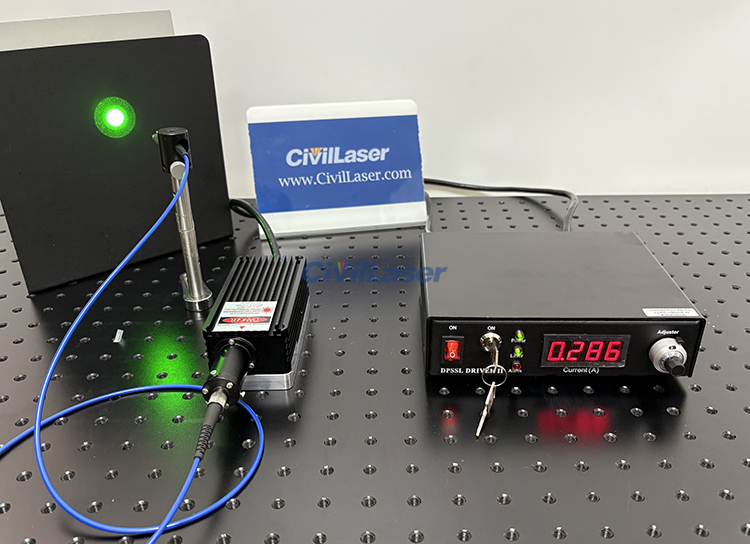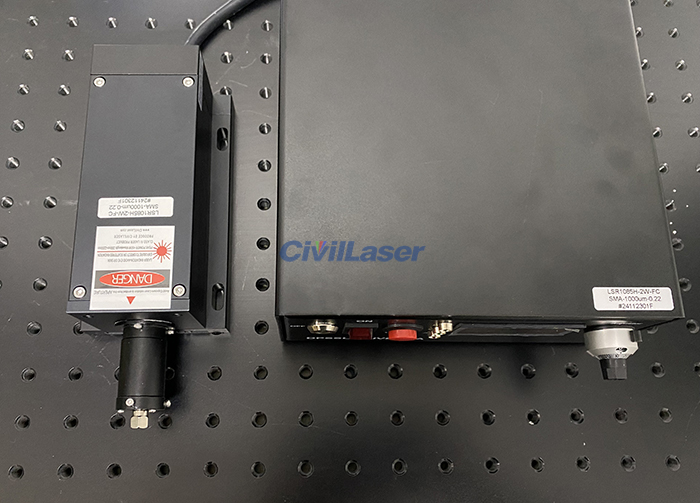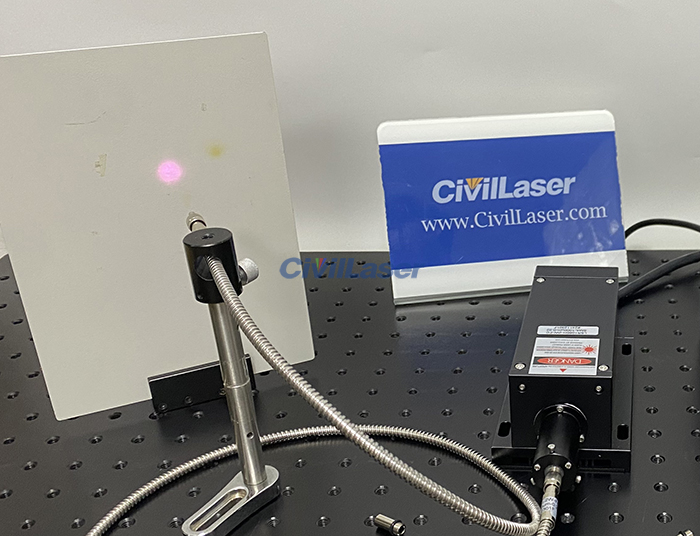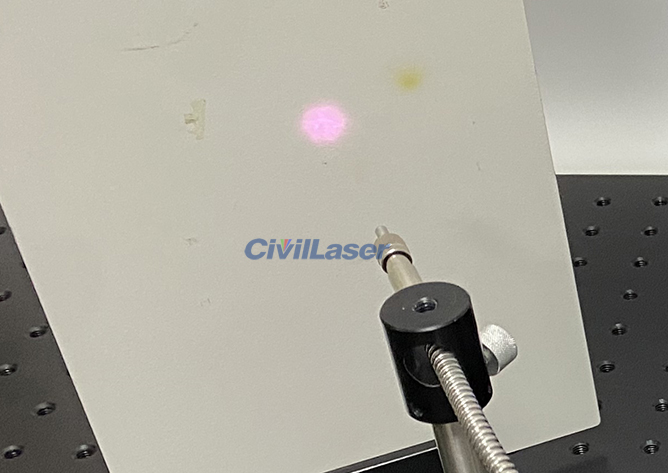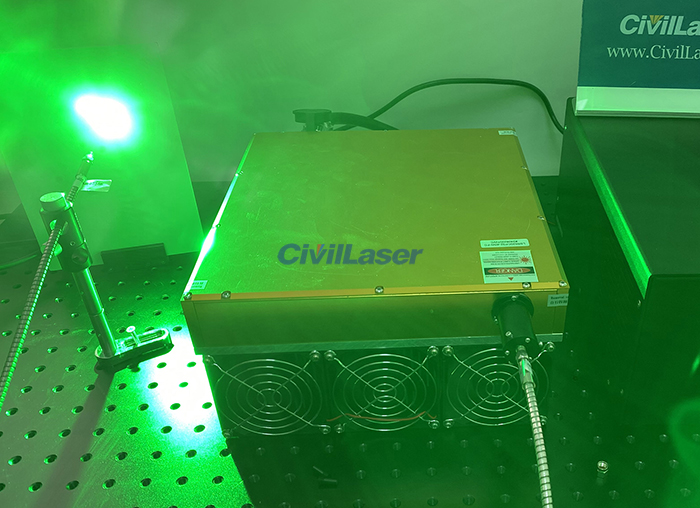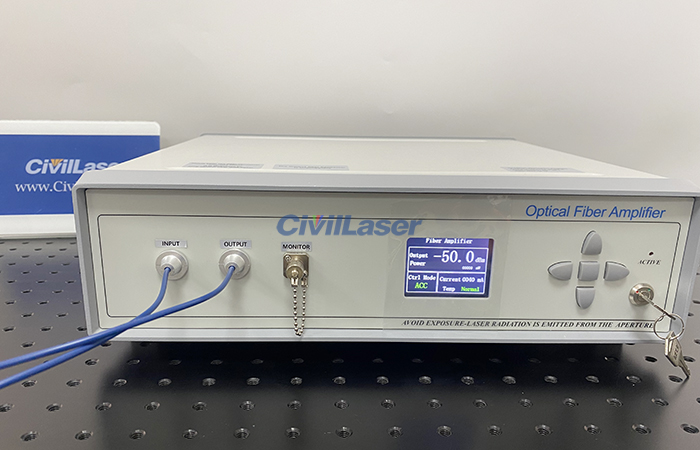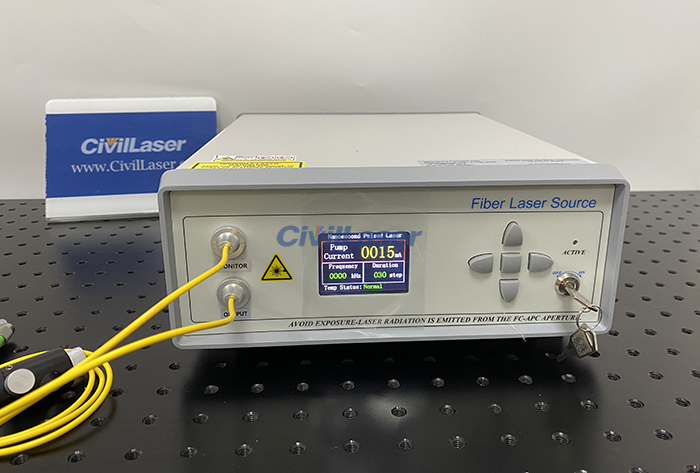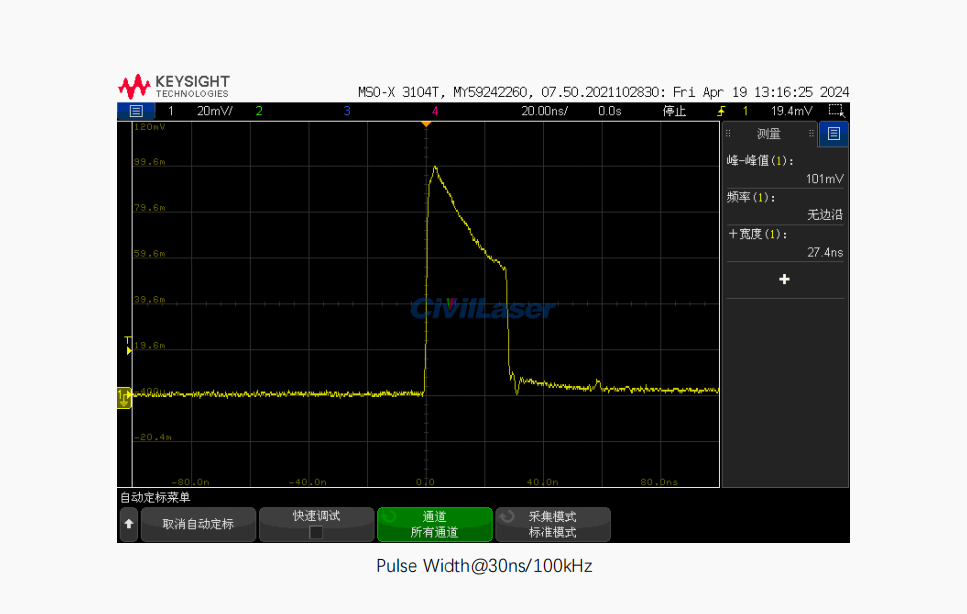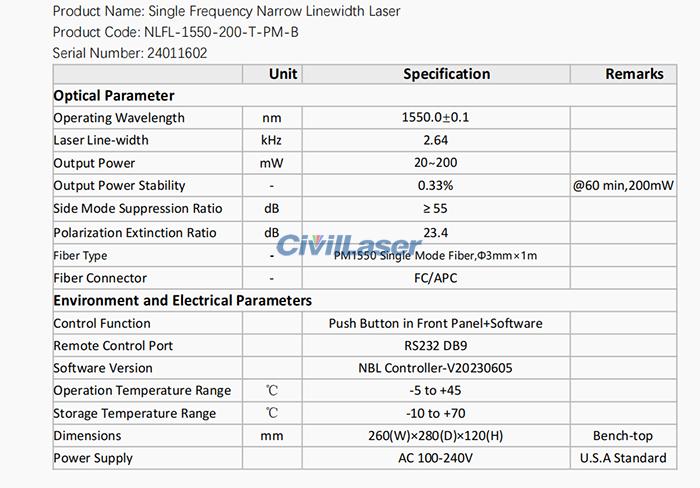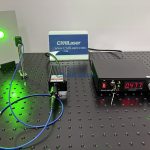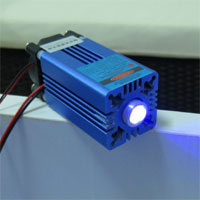Tag Archives: fiber output
530nm 1800mW Fiber Coupled Laser, Safe and Efficient Optical Tool
CivilLaser 530nm 1.8W fiber coupled laser is a high-performance laser device designed for scientific research, industrial and medical applications. Adopting advanced 530nm green laser technology, it provides excellent beam quality and stability, ensuring accurate and efficient operation.
The 530 series 1800mW fiber-coupled laser is a high-performance industrial-grade laser light source designed for precision machining, scientific research experiments and medical applications. The laser uses advanced fiber coupling technology, with a stable output power of 1800mW, excellent beam quality and wavelength stability, suitable for a variety of scenarios such as material cutting, welding, spectral analysis and biomedical imaging. Its compact design integrates an efficient heat dissipation system to ensure the reliability of long-term continuous operation. The fiber output interface is compatible with standard SMA or custom fiber configurations, can be flexibly adapted to a variety of optical systems, and supports analog/digital modulation functions to meet users’ needs for precise control and fast response.
Based on high-power semiconductor laser (LD) or fiber laser technology, the 530nm 1800mW fiber-coupled laser achieves low-loss, high-uniformity laser transmission through optimized multimode fiber output, and its beam parameter product (BPP) is better than similar products. Its built-in intelligent temperature control module and overload protection circuit can effectively extend the service life and ensure safe operation. The device supports wide voltage input and multi-protocol communication interfaces (such as RS232, USB or Ethernet), which is easy to integrate into automated production lines or laboratory equipment. With high stability, long life and low maintenance cost, the 530nm series has become an ideal choice for industrial manufacturing, scientific research innovation and medical equipment.
CivilLaser’s 808nm 70W High Power Fiber Laser
Today we will introduce an 808nm 70W high-power fiber-coupled laser. The laser module generates a lot of heat. A heat dissipation module is installed at the bottom of the laser module, equipped with 3 cooling fans. When connecting the laser module and the laser power supply, there is a small white interface on the data cable, which is used to power the cooling fan and needs to be connected. The fiber is a 400um high temperature resistant fiber. One end of the fiber is fixed on the laser. The fiber coupling efficiency is about 85%, and the output power at the fiber end is 59W. Before turning on the machine, please wear infrared laser protective glasses.
The 808nm laser is an infrared laser. It is very weak when viewed with the naked eye, but the light spot can still be clearly captured with a camera.
In the field of modern scientific research, fiber lasers have become an indispensable and important tool. Choosing a fiber laser with stable performance and support for customization is crucial to the accuracy and innovation of scientific research results. In this regard, CivilLaser’s fiber lasers are undoubtedly the first choice of many scientific research institutions.
CivilLaser has many years of experience in laser R&D and manufacturing, and its fiber lasers are known for their excellent performance and stability. Whether used for high-precision experiments or long-running complex tests, CivilLaser’s fiber lasers can always maintain efficient and stable output, providing reliable data support for scientific researchers.
In addition, CivilLaser has a deep understanding of the diverse needs of scientific research work and provides flexible customized services. Whether it is wavelength, power, or interface design, CivilLaser can tailor solutions according to users’ specific needs to help scientific research institutions better achieve experimental goals.
It is worth mentioning that CivilLaser’s fiber lasers have been widely used by many well-known scientific research institutions around the world. Its products are not only leading in technical performance, but also win the high trust of users with high-quality after-sales service.
If you’re looking for a reliable, customizable, industry-proven fiber laser, look no further than CivilLaser. We are committed to providing excellent fiber laser products to scientific researchers around the world and working with you to promote scientific progress.
1085nm 2W IR DPSS Laser Coupled Fiber Output
Today our laboratory tested a 1085nm 2W infrared fiber-coupled laser. There are 3 working modes to choose from: CW/TTL/Analog on the back of the power supply.
The laser head and power supply are labeled with model numbers. Please check whether the model numbers are consistent.
1085nm is an infrared laser, and the spot is invisible to our naked eyes. The light spot can be captured by the camera. We can also use an infrared detection card to observe the laser spot. Through the sponge test, we can see that its power is high and smoke will come out when touched.
40000mW Strong Laser Beam 520nm Green Lab Laser System
As an important part of modern science and technology, fiber-coupled lasers play a key role in many fields with their high efficiency, stability and flexibility. Among them, the 520nm 40W fiber-coupled laser has become a leader in many applications with its unique wavelength and powerful power.
The 520nm 40W fiber-coupled laser belongs to the visible light band, which makes it perform well in applications that require a specific color light source. At the same time, its power output of up to 40 watts ensures powerful laser energy and is suitable for a variety of high-demand processing and measurement tasks.
This is a 520nm 40W high power green laser. The bottom of the laser head has a heat sink, which is an aluminum heat dissipation module with 3 fans. There are 3 working modes to choose from on the back of the power supply: CW/TTL/Analog. The regulator button on the power supply is used to adjust the operating current, thereby adjusting the laser output power.
Fiber-coupled lasers efficiently couple the laser beam generated by the laser diode into the optical fiber through precise fiber coupling technology. This process requires precise focal length adjustment and angle control to ensure that the beam can enter the optical fiber without loss and be stably transmitted along the path of the optical fiber. Fiber coupling technology not only improves the efficiency of laser transmission, but also enables the laser to maintain stable performance in complex environments.
Laser output after installing the optical fiber.

With its unique wavelength and powerful power, the 520nm 40W fiber-coupled laser has shown a wide range of application prospects in many fields. Its high efficiency, stability and flexibility make it an indispensable and important tool in modern technology. With the continuous advancement of technology and the continuous expansion of application fields, it is believed that the 520nm 40W fiber-coupled laser will play a greater role in more fields.
FLH-1064-40-SM-B 1064nm 10W Fiber Laser Operation Video
This is a 1064nm 10W single-mode fiber laser. There are 2 fiber output interfaces. The ‘OUTPUT’ on the left is the actual laser output. The ‘MONITOR’ on the right is the synchronization signal output. The laser power of the synchronization signal output port is very low and is only used by customers in need.
The laser has a cooling fan. The RS232 interface here is used to connect to a computer. The current power can be displayed on the screen. The laser output power can be adjusted by buttons.
Use the buttons to adjust the laser output power:
The left and right arrow buttons select the digit, and the up and down arrow buttons adjust the value. The middle square button is the confirmation button. Turn the key to the right. The Active indicator lights up, and the laser starts outputting.
The parameter table, Spectral diagram and power stability test of this 1064nm laser.
1528~1603nm 100mW ASE Broadband SM Fiber Light Source
The fiber ASE broadband light source is an incoherent light source, which is the spontaneous radiation generated by the semiconductor laser pumping erbium-doped silica fiber, and the spectral flattening technology is introduced to achieve a broadband flat spectrum. The wavelength of the light source covers the C+L band, and the spectral flatness is better than 3dB. It is output through single-mode fiber or polarization-maintaining fiber, which is suitable for applications such as fiber sensing.
This is a C+L Band 100mW ASE broadband light source. The wavelength range is 1528nm~1603nm. The power can be adjusted by the button, and the adjustment accuracy is 1mW. The adjustment range is 10%~100%. We need to use infrared photosensitive film to observe the light spot of the laser in this band.
The test data report of this ASE broadband light source.
How to use the desktop ASE broadband light source:
Turn on the power switch on the back of the machine. After power on, the LCD displays the current power and wavelength range.
Press the middle square button to start setting the power. The left and right buttons are used to select the digit to be adjusted. The up and down buttons are used to adjust the value. Finally, press the middle square button to confirm the setting. The key is turned to ON, and the Active indicator lights up, indicating that the laser starts outputting.
Unlocking High-speed Transmission: In-depth Analysis of 40dBm Single-mode YDFA Technology
Ytterbium-doped fiber amplifier (YDFA) generates gain by pumping ytterbium-doped fiber with semiconductor laser and is used to amplify optical signals in the 1030~1080nm band. The output power is continuously adjustable and has the advantages of high gain and low noise. The desktop YDFA is convenient for experimental operation, and the user can adjust the pump current and output power through the panel buttons. A more compact modular YDFA is also provided to facilitate user system integration.
With the rapid development of optical communication technology, how to effectively enhance the intensity of optical signals and extend the transmission distance has become the focus of the industry. As an important technological innovation in this field, the ytterbium-doped fiber amplifier is gradually becoming a key device in the construction of optical communication networks with its excellent performance and broad application prospects.
The 40dBm ytterbium-doped fiber amplifier uses advanced ytterbium-doped fiber as the gain medium. Ytterbium is widely used in fiber amplifiers due to its unique energy level structure and efficient energy conversion characteristics. When pump light (usually high-power laser) is injected into ytterbium-doped fiber, ytterbium atoms absorb the energy of the pump light and undergo energy level transitions. Subsequently, when the optical signal passes through the fiber, the ytterbium atoms are stimulated to radiate photons of the same frequency as the signal light, thereby amplifying the optical signal.
It is a 1030~1070nm Ytterbium-doped fiber amplifier. The saturated output power is 40dBm @0dBm input. The 40dBm YDFA is a high-power amplifier, with an additional Monitor interface. The Monitor is used to monitor or synchronize signals with low power. And it has built-in cooling fan. Configured with RS2323 interface, available software or control command YDFA.

It supports two working modes of APC/ACC, and the two working modes can be switched by pressing the button. In APC working mode, the output power can be set. In ACC working mode, the working current can be set. Finally, press the middle square button to confirm.
The use of single-mode optical fiber as the transmission medium ensures high-quality transmission of optical signals. Single-mode optical fiber has small intermodal dispersion and is suitable for long-distance, high-speed optical communication applications.
The test data of YDFA-40-SM-B.




The 40dBm ytterbium-doped fiber amplifier has shown strong competitiveness and broad market space in the field of optical communication with its excellent performance and wide application prospects. With the continuous advancement of technology and the continuous growth of application demand, it is believed that this technology will play a more important role in the future and promote the rapid development of the optical communication industry.
Newest! 760nm Laser + Power Supply Integrated Fiber Laser
What we brought this time was the 760 1500mW all-in-one fiber laser. The laser power supply and laser output part are integrated in one chassis. There is a PC/M button on the back of the laser, the default is ‘M’ mode, that is, manual mode. ‘PC’ mode is software control mode, users can add this function. The Modulation interface on the back is used to connect 0~10KHz modulation signal. When there is no signal input, it is CW continuous working mode. Let’s check it now.
The 760nm 1500mW fiber laser integrated machine is a laser device that integrates high power, high precision and high stability. It uses a 760nm wavelength laser light source with a maximum output power of up to 1500mW, which can meet the needs of various high-precision and high-demand industrial applications.
The test data of this 760nm fiber coupled laser.
Laser output power stability diagram.
Graph of laser power and operating current in M-mode.
Output power under software, in PC mode.

Innovative Progress of 10kW Pulsed Nanosecond Fiber Laser in 1550nm Band
1550nm nanosecond pulse laser system. This high-power nanosecond laser is equipped with 2 fibers. The Ouput fiber below is the normal laser output fiber. The Monitor fiber above is a signal synchronization fiber, used for synchronizing optical signals, with a peak power of about 10mW. The signal can be built-in or external input. The yellow interface here is the signal input interface. This laser uses an external signal. You can only control the current through the button, but not the signal frequency. Let’s check it now.
The pulse width is adjustable from 3 to 200 ns, and the repetition frequency is adjustable from 1 to 3000 kHz.
The laser can be controlled via buttons. It can also be controlled through software, via RS232-USB and PC software link.
The is a shining star in modern industrial technology. Its high power output and precise nanosecond pulse control make it an ideal choice for material processing, scientific research experiments and other fields. With its unique fiber structure, this laser achieves high efficiency, long life and stability, bringing revolutionary changes to industrial production. In the future, it will continue to lead the new trend of laser technology and contribute to scientific and technological progress and industrial development.
The test data of 1550nm nanosecond high-power laser.
1550nm 3kHz Linewidth PM Fiber Laser Source Benchtop
Single frequency narrow linewidth fiber laser adopts rare earth doped fiber DFB laser cavity structure, output single longitudinal mode laser with wavelength of 1550nm, spectral linewidth is less than 3kHz, output spectral side mode suppression ratio exceeds 60dB.
What we demonstrate in the video is a 1550nm 200mW narrow linewidth fiber laser with a linewidth of 2.64kHz. The output optical fiber is available in SM/PM, here is the PM optical fiber. And it is fixed on the laser and is not pluggable. The optical fiber interface and length can be customized.
The laser output power can be adjusted through the button, the adjustment range is 10%~100%, and the adjustment accuracy is 1mW. The working Temperature can be fine-tuned, which can affect the laser wavelength. The adjustment accuracy is 0.01℃. The laser can also be controlled through software, and the interface on the laser is RS2023.
Parameter table of 1550nm narrow Linewidth Laser.









